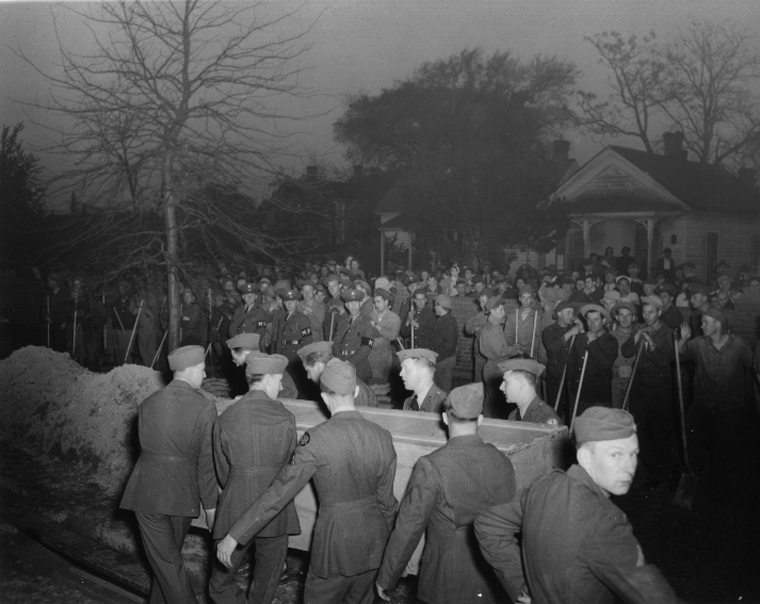Battle of the Atlantic
Just after midnight at the start of April 14, 1942, the American destroyer, USS Roper, became the first American destroyer to sink a German submarine, when she machine gunned, shelled, depth-charged and sank the German submarine U-85 off Cape Hatteras, North Carolina. Immediately afterwards, numerous men were observed in the water, but, because submarines sometimes operated in packs, no rescue attempt was made until daylight. By morning, there were no survivors among the 29 bodies that were recovered. Some of them were dressed in civilian clothes, carrying wallets with American money and identification cards. All of the dead were fingerprinted, photographed and buried in a night-time military ceremony at the Hampton National Cemetery. The wreck was in less than 100 feet of water and the United States Navy made a brief try at salvaging her. On site investigations by sport divers have raised questions about Navy reports on the sinking. Her hatch is on display in the Cape Hatteras Lighthouse visitor center and the wreck has become an attraction for divers. Most of the debris from the wreck lies within 330 feet of her hull. An Enigma machine was recovered from the wreck by private divers and in 2003 the German government agreed to allow the machine to be displayed at the Graveyard of the Atlantic Museum, in Hatteras, North Carolina.
Nighttime Military Burial of the Crew of U-85 |
 |
Just fifteen hours after U-85 was sunk, the Germans got some revenge when a single torpedo fired from submarine U-203 sank the armed British freighter Empire Thrush, 6,160 tons, on the North Carolina coast, eight miles north of Diamond Shoals. Unlike the men of U-85, all fifty-five men aboard the freighter survived the sinking to return to their families. The American Q-ship USS Asterion saw the attack on the horizon but was unable to arrive in time to engage, but was able to pick up the survivors and take them to Norfolk, Virginia.
Less than six hours after the Empire Thrush went down, the German submarine U-571 sank the unarmed American freighter Margaret, Captain Leonard Logren Davis. This time, the sinking was off Cape Cod, Massachusetts. She was torpedoed from a distance of 600 yards. One torpedo hit the stern and ripped the hull to the upper deck. The ship sank stern first within five minutes. The Germans saw survivors leave the ship, but none of her eight officers and 21 crewmen were ever found and, until records captured in 1945 revealed what had happened to her, the ship’s actual fate remained unknown to her owners and the families of the crew. The 1500 horsepower, propeller steamer Margaret was built at Sparrows Point, Maryland in 1916. She had a steel hull, was 3,352 gross tons, 1,125 net tons, 327.2' in length, 46.2' in breadth, and 22.9' in depth of hold. Her official number was 213988 and her signal letters were WKCH. She was owned by A.H. Bull Steamship Company in New Jersey and her home port was New York.
These were just three of the vessels sunk by military action that day, with others going down in other countries around the world.